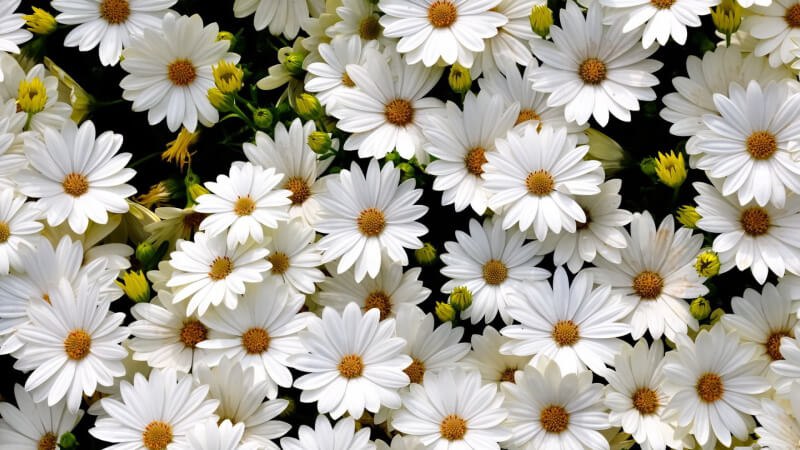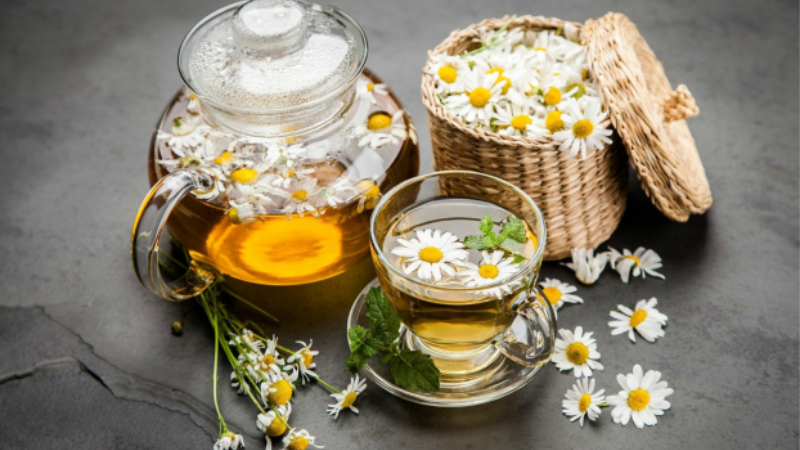What are the meanings and effects of white chrysanthemums? Let’s delve into the legends and unique significance of these exquisite flowers.
1 Unveiling White Chrysanthemums: Origin, Characteristics, and Classification
Origin and Cultural Significance of White Chrysanthemums
Chrysanthemums, with their rich history of cultivation and domestication spanning over 5000 years, hold a special place in various cultures. Japan and China are believed to be the first places where this flower flourished, and by the 15th century, it had made its way to Vietnam, enriching the country’s flora.
 White chrysanthemums, a timeless symbol of purity and elegance
White chrysanthemums, a timeless symbol of purity and elegance
In Vietnam, white chrysanthemums are grown year-round, particularly in provinces known for flower export, such as Hai Phong, Lam Dong, and Quang Ninh. These flowers usually bloom between September and November, gracing us with their beauty and fragrance.
Symbolic Meanings of White Chrysanthemums
- Purity, Simplicity, and Elegance: The pristine white color of these flowers represents simplicity, purity, and absolute cleanliness. Chrysanthemums, with their elegant beauty, are seen as a symbol of a true gentleman.
- Strong Life Force: White chrysanthemums are resilient and enduring, symbolizing a strong life force that can persevere through challenging conditions.
 White chrysanthemums embody a strong life force and resilience
White chrysanthemums embody a strong life force and resilience
- Filial Piety: An ancient legend tells of a child who tore the flower into pieces to prolong their mother’s life, thus associating chrysanthemums with filial devotion and respect.
- Remembrance and Regret: White chrysanthemums are often seen at funerals and tomb-sweeping ceremonies, symbolizing mourning and remembrance of the deceased.
- Pure and Eternal Love: The white chrysanthemum stands for a faithful and pure love, a sentiment that resonates with the flower’s unassuming beauty.
Characteristics and Botanical Classification
 White chrysanthemums, a member of the Asteraceae family
White chrysanthemums, a member of the Asteraceae family
White chrysanthemums share several characteristics with their cousins in the Asteraceae family:
- Scientific Name: Chrysanthemum sinense Sabine.
- Family: Asteraceae, also known as the Daisy family.
- Common Names: Cam cúc hoa or hoàng cúc in Vietnamese.
- Description: Chrysanthemums are herbaceous plants with a mild, pleasant fragrance. They have long, dark green stems that grow upright, reaching heights of 0.5 to 1.4 meters. The small leaves, resembling the size of a pinky finger, are covered in fine hairs.
- Roots: The roots of chrysanthemums are clustered and feature extensive, hair-like structures.
- Leaves: Shaped like lance tips, the leaves boast a deep green color and serrated edges. They grow along the lower part of the plant, with stems measuring 1 to 2.5 centimeters in length.
- Petals: White chrysanthemums have numerous long petals with rounded tips that radiate outward, forming beautiful clusters at the ends of branches or in the axils of leaves.
- Stamen: The center of the flower, known as the stamen, is yellow and round, resembling the heart of a sunflower.
2 The Many Benefits of White Chrysanthemums: From Health to Beauty
Health Benefits of White Chrysanthemums
Traditional Chinese Medicine
 White chrysanthemums are valued in Traditional Chinese Medicine
White chrysanthemums are valued in Traditional Chinese Medicine
In Traditional Chinese Medicine, white chrysanthemums are prized for their sweet and bitter flavors, as well as their slightly cold nature. They are used in herbal remedies to treat ailments such as headaches, eye pain, tearing eyes, high blood pressure, and fever. The unique flavor of white chrysanthemums is also used to infuse liquor or tea.
Modern Medicine
 White chrysanthemums offer a range of health benefits, backed by modern science
White chrysanthemums offer a range of health benefits, backed by modern science
Nutritional Profile: White chrysanthemums are packed with vitamins and minerals. Specifically, 51 grams of these flowers provide a wealth of nutrients:
- 0.481 mg of Vitamin E
- 17 mg of Vitamin C
- 0.07 mg of Vitamin B6
- 0.09 mg of Vitamin B2
- 48 mg of Calcium
- 289 mg of Phosphorus
- 60 mg of Magnesium
- Essential oils
- Mucilage
- Organic acids
- And more…
These nutrients offer a multitude of health benefits:
Cardiovascular Health: White chrysanthemums contain flavonoids, which help lower blood pressure and cholesterol levels, promoting a healthy heart. Chrysanthemum tea is also known to alleviate dizziness, insomnia, and headaches.
 White chrysanthemums support heart health
White chrysanthemums support heart health
Cold and Flu Relief, Detoxification, and Liver Support: The cooling properties of white chrysanthemums make them an effective remedy for wind-cold or high fevers. They help alleviate symptoms like swelling and headaches. Additionally, combining dried white chrysanthemums with herbs like golden thread and dandelion supports liver detoxification and treats skin issues.
 White chrysanthemums offer relief from cold symptoms and support liver health
White chrysanthemums offer relief from cold symptoms and support liver health
Eye Health: Rich in Vitamin A, white chrysanthemums are excellent for relieving eye pain, dryness, or redness caused by prolonged screen time or intense work.
 White chrysanthemums promote healthy eyes
White chrysanthemums promote healthy eyes
Cancer Prevention: White chrysanthemums contain apigenin, a compound that helps prevent the spread of cancer cells and enhances the effectiveness of cancer treatments.
Insomnia and High Blood Pressure: Chrysanthemum tea works to dilate blood vessels, lower blood pressure, and calm the nervous system, promoting better sleep and relaxation.
 Chrysanthemum tea soothes the mind and body
Chrysanthemum tea soothes the mind and body
Menstrual Cramps: Compounds in white chrysanthemums help reduce uterine contractions. Drinking chrysanthemum tea or applying oil extracted from the flowers to the lower abdomen can ease painful menstrual cramps.
 White chrysanthemums provide relief from menstrual discomfort
White chrysanthemums provide relief from menstrual discomfort
Wound Healing and Antibacterial Properties: Chrysanthemums exhibit antibacterial properties, effectively combating bacteria such as Streptococcus and Staphylococcus.
 White chrysanthemums exhibit antibacterial properties
White chrysanthemums exhibit antibacterial properties
Oral Health: The antibacterial properties, combined with the mild fragrance of white chrysanthemums, help eliminate bad breath-causing bacteria and support the treatment of gingivitis.
Skincare Benefits of White Chrysanthemums: The essential oils found in white chrysanthemums offer a multitude of skincare benefits, including moisturizing the skin, fading dark spots, and cleansing pores.
 White chrysanthemums enhance your skincare routine
White chrysanthemums enhance your skincare routine
Eczema Relief: The gentle nature of chrysanthemums helps soothe skin irritation, supporting the treatment of eczema.
Feminine Hygiene: The antibacterial properties and mild fragrance of white chrysanthemums help prevent vaginal infections and maintain feminine hygiene.
3 Growing and Caring for White Chrysanthemums: A Gardener’s Guide
Growing White Chrysanthemums at Home
 Mastering the art of growing white chrysanthemums
Mastering the art of growing white chrysanthemums
Seed Preparation: Obtain white chrysanthemum seeds from a reputable seller to ensure a high germination rate and minimize the risk of pests and diseases.
Preparing Cuttings: Select healthy chrysanthemum stems for cuttings, ensuring they are 5-7 cm in height, with 5-7 leaves, a stem diameter of approx. 0.2 cm, and roots measuring 0.5-3 cm in length (smaller roots should be less than 4 cm).
Soil Preparation: Choose nutrient-rich soil, such as loam, alluvial soil, or clay loam, to promote the plant’s growth. Adjust the soil’s pH to 6-6.5, ensuring it is loose, well-drained, and airy. Adding compost, straw, or coconut coir can accelerate growth.
Planting Time: The ideal time to sow seeds or plant cuttings is during mild weather (early spring or late summer) and in the late afternoon or early evening, when the sun is less intense. Maintain a temperature range of 22-26°C, providing ample ventilation and gentle sunlight.
Caring for Your White Chrysanthemums
 Caring for your white chrysanthemums ensures their beauty and abundance
Caring for your white chrysanthemums ensures their beauty and abundance
Watering: When you first sow the seeds or plant the cuttings, water them daily for the first week to maintain moisture and promote germination or root development. Thereafter, water them once a week.
Soil Care: Remember to mound the soil, remove weeds, provide sufficient water, and loosen the soil around the plants to ensure optimal growth. White chrysanthemums prefer well-drained soil and good air circulation.



































